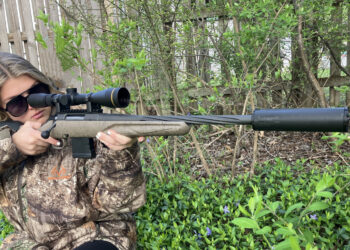By Christopher R. Bartocci
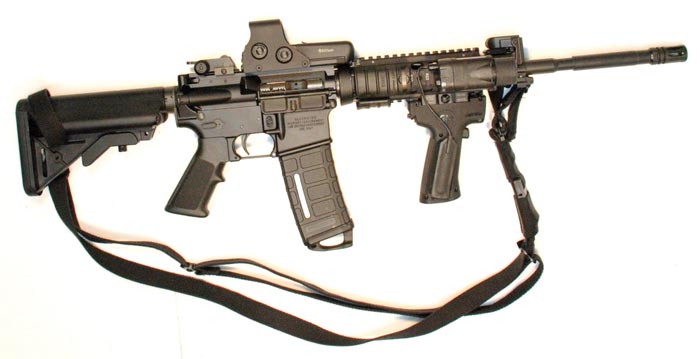
With events such as school shootings, increased ability, use of body armor and 911, law enforcement agencies have been updating their armories. Perhaps the Homeland Security grants help many agencies get equipment they normally would not have the money to procure. Small town police departments are starting emergency response teams and training in schools in the event history repeats itself in their jurisdiction.
The patrol carbine has either been added to the police arsenal for select officers or replaced the shotgun all together. The carbine offers the ability for an officer to handle situations he would normally have to call a SWAT team in for. It provides individual firepower of both accuracy and penetration that can not be obtained with a pistol or shotgun.
The patrol carbine is not selective fire, but semiautomatic only. However, the weapon provides all the benefits of the combat proven M4 carbine such as accuracy, reliability, versatility and the ability to mount accessories. There are many patrol carbines on the market today. Among the most prolific is the Colt Law Enforcement Carbine (LE6920). This will be the baseline rifle to build the ideal patrol carbine.
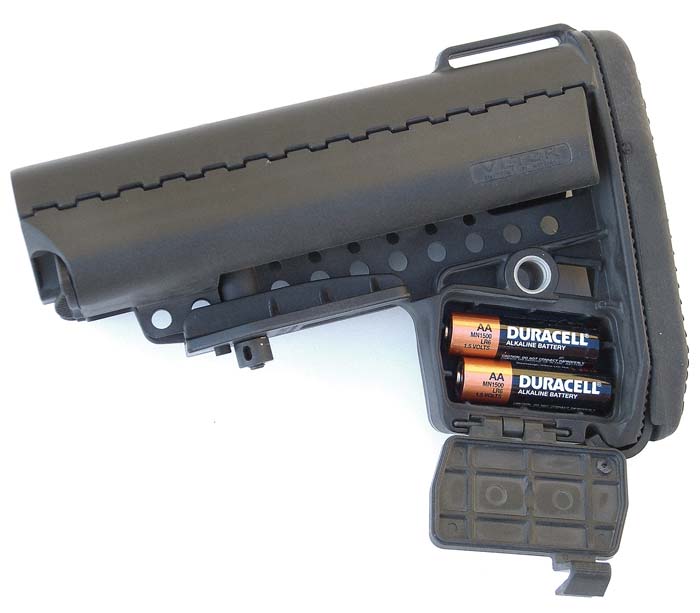
The Colt Law Enforcement Carbine (LE6920)
The Colt Law Enforcement Carbine is the premier patrol carbine in the country. The carbine provides all the reliability enhancements of the combat proven Colt M4 carbine. Several things set this carbine aside from the competition. Colt Defense is one of the few firearms manufacturers whom have their own in-house metrology laboratory. Prior to raw materials being received by Colt, samples are taken of the material to insure that the materials are what they say and are made to Colt specifications. Due to Colt being a government contractor all their parts receive the same quality control and standards regardless of their status as military, commercial or law enforcement weapons – there is one standard. All bolts and barrels are proof tested with a 70,000 psi proof cartridge and then magnetic particle inspected to insure no defects in material. All firearms are test fired and targeted before they leave the factory. The law enforcement weapons also benefit from any upgrade or improvement to the government issue M4. The aforementioned reasons are why the author chose the LE6920 as the baseline firearm.
The LE6920 has a 16.1 inch barrel which is rifled with a 1:7 inch twist. The barrel is chrome plated and has a step-cut for installation of a M203 grenade launcher. This ability may be important if the agency wishes to mount a M203 to deploy less than lethal munitions or gas. The rifle comes standard with a compensator and M4 double heat shield handguards. The flattop Mil-Std 1913 upper receiver has a detachable carrying handle mounted to it and the rifle is equipped with a four position telescopic stock. The rifle weighs a light 5.95 pounds. No functional components of the rifle’s mechanism should be altered. This could cause the weapon to malfunction or an unintentional discharge. The trigger mechanism, buffer and bolt carrier group should not be altered nor modified in any way. This should also be in accordance with most police agencies policies and procedures.
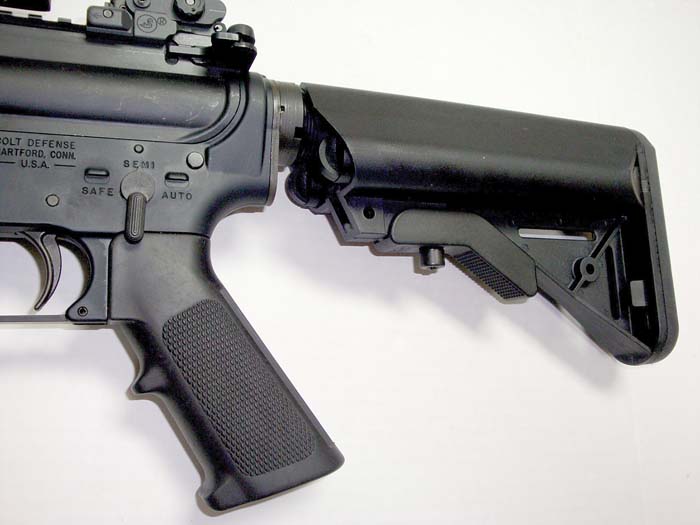
Building a Patrol Carbine from the Back to the Front
The stock that the LE6920 comes with is more than suitable for a patrol carbine. Based on examination of numerous different stocks, there are two reasons why you may want to replace it. First is if the carbine will utilize optics that require batteries and second is if the rifle stock is uncomfortable for the shooter. The optic that was chosen for this patrol carbine utilizes standard AA batteries and if those batteries were to die at an inopportune moment, it could be catastrophic to the officer. After looking at many stock options, the stocks were narrowed down based on military drop testing results and their ability to store batteries for the optic. The three top stocks found are the VLTOR E-Mod stock, the VLTOR Modstock and the Lewis Machine and Tool SOPMOD stock. The one chosen for this patrol carbine is the VLTOR Modstock. The Modstock has two battery storage compartments that will accept AA and 123 batteries. The stock has an extremely comfortable triangular shape cheek weld making it significantly more comfortable than the standard GI stock. It is compact enough so that an officer wearing body armor will be comfortable. The VLTOR E-Mod stock has similar features, is built stronger than any other stock examined and has a club-foot design. It is longer, has a rubber butt pad and also has a battery storage compartment along with an additional compartment that would hold batteries or spare parts. The Modstock was found to be more comfortable and easier to manipulate by the author. The LM&T SOPMOD stock, like the VLTOR stocks, has a battery storage compartment but unlike the VLTOR stocks, the SOPMOD stock must be removed from the rifle and the storage tubes removed to retrieve the batteries. The VLTOR stock just has to have the watertight caps removed. The smoothness of the SOPMOD stock makes it extremely comfortable and is easy to manipulate. The SOPMOD stock is combat tested and is standard equipment on most all Navy and SOCOM Colt M4A1 carbines and Mk18 Mod0 carbines. There are many options out there and these are but a few. Another plus found with VLTOR is in their combo kit comes a 5-position receiver extension, Mil-Spec diameter. There are numbers on top of the receiver extension alerting the operator to what position it is set.

Additionally to the stock is the various ways to mount a sling. The VLTOR stocks all have receptacles for a quick detachable sling swivel and they can be mounted left or right side of the stock. Trends today point to another direction as there is significant interest in 1-point sling adapters. This design attaches the sling to a mount located at the rear of the lower receiver of the rifle. The stock attaches by a clamp to the adapter. These are offered by many manufacturers. The one chosen is the one made by VLTOR and is a universal adapter. There is a screw and bushing that allow the adapter to be mounted to either the left or right side of the rifle. This requires removal of the receiver extension of the rifle and replacing the receiver end plate with the 1-point sling adapter receiver end plate. This should only be done by a qualified and properly trained armorer. The receiver locking nut must be properly torqued down and staked.
Most patrol carbines will be equipped with optics. If the weapon is not, the detachable carrying handle that comes with the LE6920 may be used effectively. There is no need to replace it. Iron sights are very effective as they have been since the firearm was invented. This patrol carbine will utilize an optic so a BUIS (Back-Up Iron Sight) should be used. This sight allows in the event of an optic failure for the operator to get back into the fight by engaging the BUIS and firing the rifle with iron sights. Many of the rifle/optic combinations will offer co-witness with the iron sights through the optic. There are numerous BUIS’ available on the market and three were identified as being the most durable and battle proven designs. First is the Knight’s Armament Company BUIS. This sight is offered in two models; one which is adjustable for windage only and the other is elevation as well as windage. These sights have been in use by SOCOM for many years on their M4A1 carbines, Mk12Mod 0 SPR and Mk18 Mod 0 CQB carbine. The second is the A.R.M.S. #40-L. This is a folding sight that has both flip up long and short range apertures and can be had with 1/2 inch MOA click at 100 yards adjustments. The entire #40 series are spring loaded and latched with a lever. The lever is pulled and the sight is engaged. All #40 BUIS are adjustable for windage only. The third, and the one placed on this patrol carbine, is the Matech BUIS. This BUIS is standard issue for the U.S. armed forces. Initially developed for the Air Force, this BUIS is adjustable for windage as well as elevation. A lever on the left side of the BUIS allows the shooter to adjust elevation from 200 to 600 meter. Again, there are many choices in the industry and these are the most widely used and proven designs.
Most patrol carbines will be required to have a tactical light mounted to them. In fact, many patrol carbine courses require them. There are several ways to mount tactical lights to an M4-type rifle and some are better than others. The first and least preferable method is mounting the light directly to the barrel. These mounts are easily broken or damaged and longer hand held flashlights are used. The second is purchasing a set of handguards with a built in tactical light such as the Surefire model M500A Millennium fore end that replace the handguards the weapon is provided with. Although an excellent design, it is expensive and does not offer much versatility. The other and most exercised option is the use of a rail system. There are several tactical flashlight options available on the market today and the one chosen for this patrol carbine is the Insight Tech-Gear M3X tactical light. Mounted to the end of the right rail this light could be activated by either a switch or a pressure pad. The pressure pad was utilized and mounted to a Colt Grip Laser (CGL). With the switch being set to MOM (momentary) position the light is controlled by the pressure pad. This system enables the officer to move covertly and light applied at the exact moment needed.
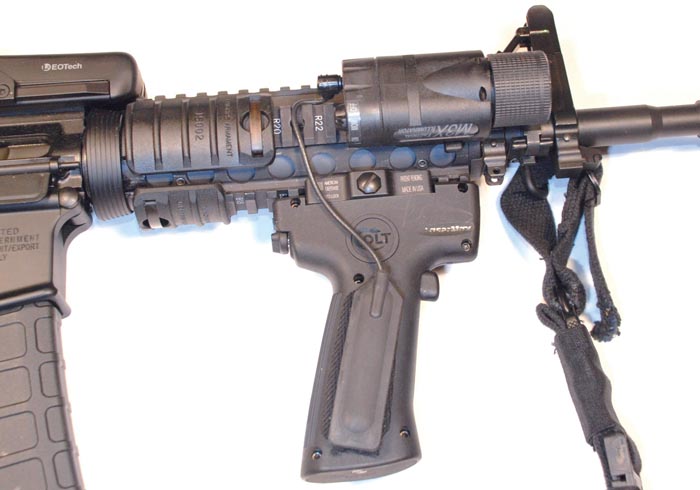
Tactical Laser Sights
For law enforcement/military use, laser sights have proven itself beyond reproach. Maybe the best tool you can give a police officer is a tool which may prevent them from having to fire their weapon and the laser sight does just that. The media has actually helped law enforcement in this area as the use of laser sights are shown in many action movies. People universally know if they see a red dot on them something really bad could happen and makes them think twice if they should really be doing what they are doing. Many officers have stated that in real world situations, the potentially lethal situation was defused by using a laser sight on the suspect. The intimidation factor is, in this author’s opinion, the number one benefit of the laser sight, with the second being accuracy and the third speed. When shooting around corners, from confined locations and under abnormal conditions where the weapon can not be brought to the shooters shoulder, the use of a laser will permit an accurately placed shot in a close quarter battle (CGB) environment. The laser sight will also increase the speed of the shot by enabling the officer to get off a well aimed shot before he brings the optic to eye level.
There are many options for lasers: some are large and some are small. You have red, green, orange and, for departments who use night vision, there are infrared lasers. They are mounted to the rail of a handguard, spring guide of a pistol or a multi diode box (PEQ 2 and 4). For rifles, the most effective way is to mount inline with the bore. In this case, the laser needs to be mounted under the barrel in the 6 o’clock position. Lasers that are mounted to the side are only accurate at the specific zeroed range. As the target gets closer and further away from that point it will shift left or right depending on which side of the rail it was mounted. If your side mounted laser was zeroed to point of aim at 10 yards, your point of aim will usually be off the target as close as 25 yards. Two lasers were chosen and performed well at all CQB ranges (0 to 50 yards). The first one, and the one chosen for this patrol carbine, was the Colt CGL (Colt Foregrip Laser). This combines an inline with bore laser sight and a track light for discrete illumination a vertical pistol grip. The laser is zeroed by the user and has adjustments for both windage and elevation. The laser, by a switch, can be constant on or pulsate. The track light can be used for low level discrete illumination not to be confused with a full power tactical light that is designed to light up a room. Another benefit is that it uses normal AA batteries that are affordable and common as opposed to expensive 123A batteries. The second choice was a light and laser combo manufactured by Insight Tech Gear, the M6X. This combines a high power tactical light with a laser. A switch allows it to allow light only, laser only or laser and light. Also there is another switch to permit an off position, a momentary (uses a pressure pad) or constant on. This model attaches right to any Mil-Std 1913 rail and may be used on a rifle or handgun. The lasers used for this article were zeroed in with a laser bore sight at 10 yards to point of aim. The laser consistently held center match out to 50 yards which was as far as the low level light shooting was done.
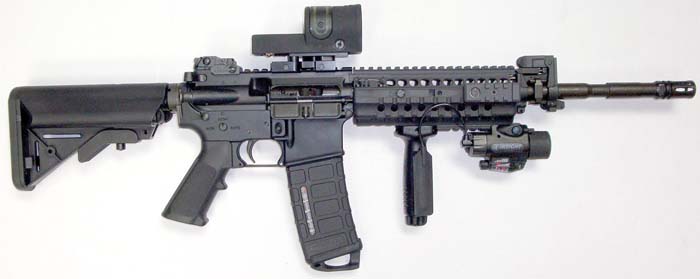
Rail Systems for the Tactical Rifle
Rail systems will replace the handguards. Quad Mil-Std 1913 rails are offered allowing multiple attachments to be utilized on the rifle such as tactical light, vertical pistol grip, laser designator, and optic or night vision scopes. While there are many rail systems available, few are really tried and tested in combat. Two rail systems were looked at based on their combat usage and their tried performance. The Knight’s Armament Company M4 RAS system perhaps is perhaps the most widely utilized rail system for the M4 platform of rifles in use today. This rail is supplied with every M4 carbine Colt Defense ships to the U.S. military. The U.S. Marine Corps has the M5 RAS mounted on all of the M16A4 rifles that they procure. This rail is mounted in less than a minute to the LE6920. The handguards are removed and the spring loaded tongue on the front of the rail is inserted under the lip of the handguard cap and a mounting bracket sits over the gas tube and when screwed in, locks into the barrel nut. The lower handguard front end is inserted inside the lip of the handguard cap and locked in place by the delta ring. This model is shown on this patrol carbine. Also shown is the A.R.M.S. SIR System. This is another proven rail system that sees use all over the world. Several models are offered. The #50C is easily adapted to any rifle and needs no modifications to the rifle. The sleeve is attached to the Mil-Std 1913 rail on the upper receiver and a bracket secures the front of the system to the barrel nut. This system offers a free floated barrel and quad rails. Shown is the #50M-CV that was developed for the special operations forces. This handguard requires the delta ring, spring and slip ring be removed. The rail attaches directly to the barrel nut. This is a slimline and sleek rail. The SIR system has an additional advantage: the barrel is left to free float increasing accuracy and promotes cooling. Any one of these rail systems will enable the patrol carbine to have the versatility of the M4 carbine and allow the officer to attach whatever accessories that will help him complete his mission.
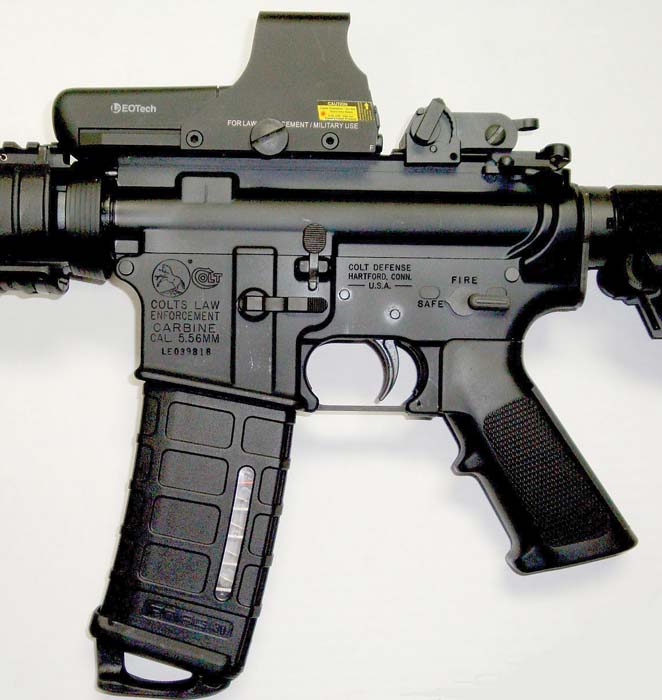
Folding Front Sight Assembly
As received, the Colt LE6920 carbine comes with the standard front sight tower that is typical on every rifle regardless of the manufacturer. Most rifles are equipped with folding rear sights but the front is still stationary. Often, the front sight assembly is an obstruction to optics placed on the rail. Many current weapons are being designed with folding front sights. A.R.M.S., Inc released at the 2008 SHOT Show their #41-B Silhouette folding front sight assembly. Perhaps the finest folding front sight in the market, this folding front sight is offered in two configurations. For existing rifles with pinned on front sight bases, A.R.M.S. offers a 41-B, which is attached by two bolts to the barrel. The flash suppressor/compensator and two taper pins are removed from the front sight base is removed. The gas tube is placed and pinned in the 41-B and placed back on the rifle. The front sight base is squared and tightened down to approximately 45 inch pounds. The second version is pinned on just like the standard Colt front sight base. This is done with a clean barrel which has never been drilled for use with taper pins. The 41-B is easily engaged with one finger and has the triangular shape of the standard front sight base. To disengage, merely push downward on the arm behind the front sight base and the sight will fold. A folding front sight is an enhancement for any rifle that utilizes optics.
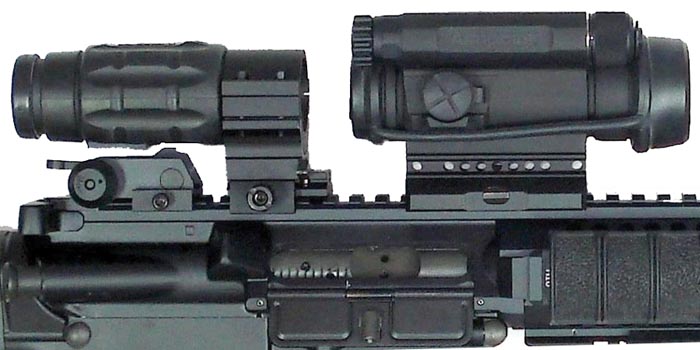
Don’t Forget the Southpaws
For those with left handed officers, some quick modifications can be made to the rifle to accommodate the southpaw. When the Canadian military went to the mid-life update of their C7 rifle to the C7A2, the rifle was to be ambidextrous by modifying two critical components. First was the charging handle. The standard latch was replaced with a latch that extended to the right side enabling a lefty to easily operate the bolt. Most left handed shooters will actuate the bolt with the charging handle instead of the bolt catch. The second is they added an ambidextrous magazine release that required no modification to the rifle. It is manufactured by Norgon and licensed to Colt Canada for them to produce. The button is located on the rear of the left side of the mag release. The Norgon ambidextrous magazine release is easily manipulated with the left hand and, in some cases, is a benefit to right handed shooters as well.
If the department has a newly manufactured Colt LE6920 manufactured over the last year, the new rifles have a reversible selector lever. Colt Defense developed a reversible selector lever that only requires the pistol grip removed, hammer removed and the selector lever pulled out and inserted from the opposite side. This new and improved selector lever is also longer and easier to manipulate as well as stronger. These new selector levers are for semiautomatic rifles only and can be purchased from Specialized Armament Warehouse.
The charging handle can just as well be easily altered to make it more accessible to left handed shooters. Actually, this modification can just as easily benefit the right handed shooter as well. For this rifle, the Precision Reflex, Inc. Gas Buster charging handle sports a large release latch this is accessible to right and left shooters alike.
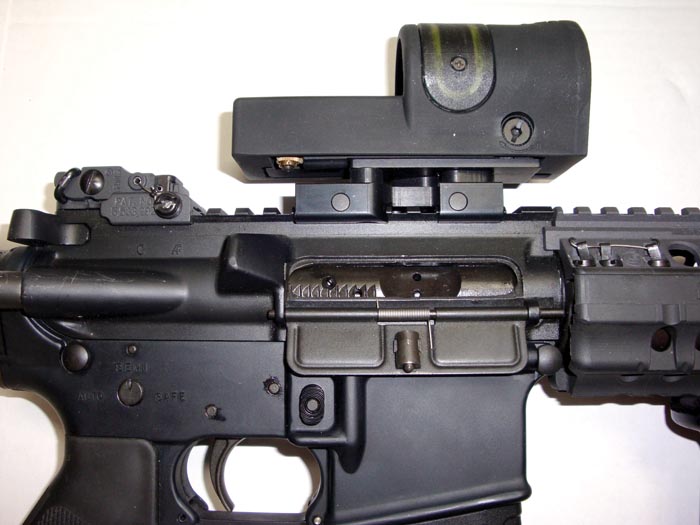
Optics for the Patrol Carbine
Choosing the proper optic is very important. The most practical optic for a patrol carbine is a reflex sight or a red dot sight without magnification. Most police confrontations are going to be at extreme close quarters within rooms or buildings and shots beyond 50 yards are rare. Magnified optics has their place on containment weapons. However, magnified optics are a poor choice for CQB. If magnified optics is required, they should not exceed 4X. Beyond that it is more difficult to obtain a clear sight picture quickly and the acquisition is affected by rather little movement.
Three reflex sights were considered. The first, and one chosen, is the AimPoint Comp 4 red dot sight. This sight is issued by the U.S. Armed Forces. It is powered by commercially available AA batteries with an extended battery life. The optic is wide open and allows use of peripheral vision as both eyes should be open. The size of the dot and its intensity can be adjusted by a dial. The battery life is an amazing 80,000 hours with a good quality battery. The second optic looked at was the EOTech holographic sight, model 512.A65/1. This is a holographic sight powered by two commercial AA batteries and the intensity of the crosshair in a circle reticle’s brightness can be adjusted. The optic has a wide screen as well for excellent depth perception. The third one looked at was the brand new Trijicon model RX30 reflex sight that is based off their combat proven reflex sight. This one is really an improvement over the old in a couple areas. The much larger 42mm objective increases the operator’s peripheral vision and the sight is powered by both fiber optics and a tritium lamp. What this means is no batteries. Although significantly larger than its predecessor, it is well worth it. This world class reflex sight will find a heavy following in the law enforcement market.
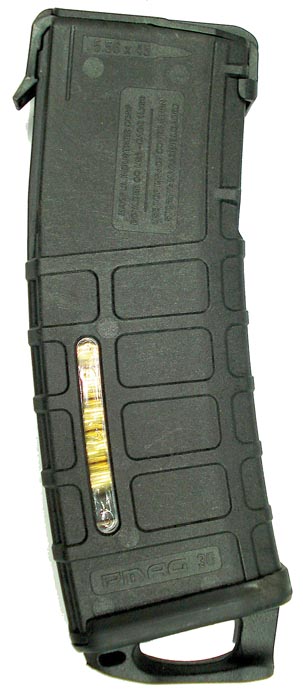
Selecting a Magazine
The magazine is the heart and sole of the rifle. Current aluminum magazines have served the rifle well but have always been thought of as the weapon’s weakest link. The design intent of the magazine was for it to be disposable. The magazine works well but is easily damaged. Leaving aluminum magazines loaded over extended periods of time can cause the feed lips to separate as well as the spot welds to break on top of the magazine. Until recently, there were no options for product improved magazines. The early attempts with synthetic magazines were a failure. Early plastic magazines were brittle and broke very easily. The Canadians developed a polymer magazine but their Army rejected it in favor of the aluminum ones. However, their second try gave a decent reliable magazine. But those would never be imported into the U.S. Magpul Industries designed and produced their polymer magazine, the PMag and, based on experience gained, is perhaps the finest magazine in the world for the black rifle. Utilizing advanced polymer, these synthetic magazines solve many of the reliability and durability issues that have plagued the aluminum magazine since its inception. The PMag feed lips are stronger than those of the aluminum and, unlike aluminum or steel, polymer has no memory. Of you drop an aluminum magazine and the material bends, it stays that way. The PMag will go back to its form. If it is damaged, you will know it because the magazine would break. The aluminum one will not be realized until it fails in the rifle. The PMag will offer longer durability, reliable if left loaded for extended periods of time as well as it is designed to load to its full 30-round capacity and insert easily in a rifle with a closed bolt.
Building a patrol carbine is the combination of a reliable weapon, effective optic, emergency back up sights as well as a good tactical light. Of course there are other gadgets, but the bare bone necessities are what we discuss. There are many ways to go about this. There are a number of manufacturers making excellent accessories. It is important to do your homework: determine what type of area you operate in and from there you map out what your needs are.
| This article first appeared in Small Arms Review V13N3 (December 2009) |





